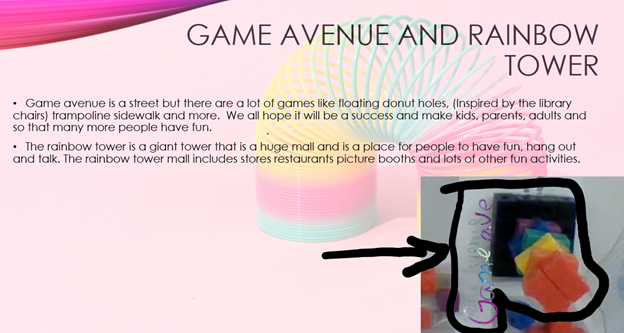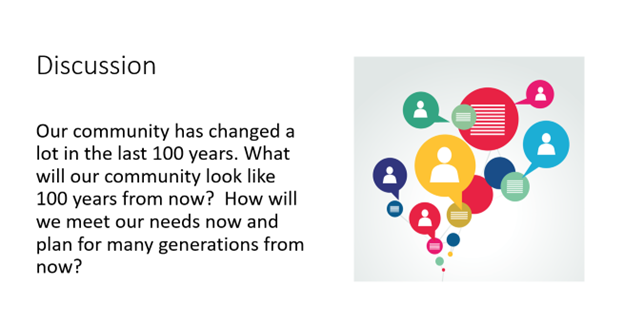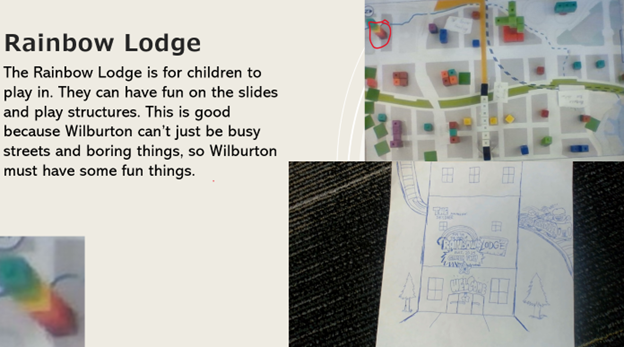Piloting a Planning Curriculum
Washington By and By Enters the Classroom
This past spring, students in several fourth grade classrooms across Bellevue School District got their first taste of urban planning as teachers  piloted a new curriculum designed to “build critical thinking, problem solving, and participatory skills to become engaged citizens.” Social studies curriculum developers in collaboration with members of APA-WA’s Youth in Planning Task Force crafted 11 lessons introducing students to Washington State’s Growth Management Act, the three pillars of sustainability, and the four domains of global competence: investigate the world, recognize multiple perspectives, communicate ideas, and take action. piloted a new curriculum designed to “build critical thinking, problem solving, and participatory skills to become engaged citizens.” Social studies curriculum developers in collaboration with members of APA-WA’s Youth in Planning Task Force crafted 11 lessons introducing students to Washington State’s Growth Management Act, the three pillars of sustainability, and the four domains of global competence: investigate the world, recognize multiple perspectives, communicate ideas, and take action.
Lessons began with students exploring how their communities had evolved over time illustrating the importance of intentionally planning for a city’s needs now and in the future. By watching King County’s video on the Growth Management Act, students learned by guiding growth carefully and focusing it near city centers, urban planning helps keep our air and water clean, fight climate change, preserve our farmland, forests and natural areas and keep King County a sustainable, vibrant, and healthy community for everyone.
 Students next explored tradeoffs between energy use and environmental protection, gaining experience balancing competing objectives. They learned the importance of considering multiple perspectives with the help of Washington, By and By, a graphic novel about community planning illustrating how empowered youth can engage and shape the future of their state. With this awareness, students learned how intentional urban design can reveal elegant solutions that increase accessibility for everyone. Students next explored tradeoffs between energy use and environmental protection, gaining experience balancing competing objectives. They learned the importance of considering multiple perspectives with the help of Washington, By and By, a graphic novel about community planning illustrating how empowered youth can engage and shape the future of their state. With this awareness, students learned how intentional urban design can reveal elegant solutions that increase accessibility for everyone.
Finally, students put all they learned into practice by developing a plan for an area  within the city poised for transformation. Learning about the community’s vision and goals, students grappled with decisions about what types of land uses to allow where and why. They learned how collaboration fosters more equitable planning, and how public art can enhance livability and strengthen a place’s identity. Once their plans were complete, students developed presentations illustrating their plans and invited planners from the City of Bellevue to their classroom to hear their ideas. Students shared their plans highlighting ways to leverage the existing strengths of the subarea including nearby hospitals and a recreational trail, while adding new features to make the area welcoming, sustainable and fun. They emphasized the benefits of mixing land uses close together, situating hotels near a lake, and making the area inviting and fun with features such as an avenue of games, a rainbow lodge, a national technology museum, a treehouse mansion, a pet café and a splash mountain. within the city poised for transformation. Learning about the community’s vision and goals, students grappled with decisions about what types of land uses to allow where and why. They learned how collaboration fosters more equitable planning, and how public art can enhance livability and strengthen a place’s identity. Once their plans were complete, students developed presentations illustrating their plans and invited planners from the City of Bellevue to their classroom to hear their ideas. Students shared their plans highlighting ways to leverage the existing strengths of the subarea including nearby hospitals and a recreational trail, while adding new features to make the area welcoming, sustainable and fun. They emphasized the benefits of mixing land uses close together, situating hotels near a lake, and making the area inviting and fun with features such as an avenue of games, a rainbow lodge, a national technology museum, a treehouse mansion, a pet café and a splash mountain.
 City planners were blown aware by the students’ presentation skills and gained insights into what youth value as well as inspiration for making the subarea inviting to all ages. Students’ input will feed into revised policies for the subarea and one day students may see the fruits of their input with a mix of uses, an avenue of games, a colorful tower or perhaps even a large tree house. As students become more aware of the importance of sharing their perspective, their agency to affect change, and the importance of planning to meet the needs of our region for generations, we hope they will continue to engage in local planning processes and consider urban planning as a worthy profession to consider. City planners were blown aware by the students’ presentation skills and gained insights into what youth value as well as inspiration for making the subarea inviting to all ages. Students’ input will feed into revised policies for the subarea and one day students may see the fruits of their input with a mix of uses, an avenue of games, a colorful tower or perhaps even a large tree house. As students become more aware of the importance of sharing their perspective, their agency to affect change, and the importance of planning to meet the needs of our region for generations, we hope they will continue to engage in local planning processes and consider urban planning as a worthy profession to consider.



|

 piloted a new curriculum designed to “build critical thinking, problem solving, and participatory skills to become engaged citizens.” Social studies curriculum developers in collaboration with members of APA-WA’s Youth in Planning Task Force crafted 11 lessons introducing students to Washington State’s Growth Management Act, the three pillars of sustainability, and the four domains of global competence: investigate the world, recognize multiple perspectives, communicate ideas, and take action.
piloted a new curriculum designed to “build critical thinking, problem solving, and participatory skills to become engaged citizens.” Social studies curriculum developers in collaboration with members of APA-WA’s Youth in Planning Task Force crafted 11 lessons introducing students to Washington State’s Growth Management Act, the three pillars of sustainability, and the four domains of global competence: investigate the world, recognize multiple perspectives, communicate ideas, and take action. Students next explored tradeoffs between energy use and environmental protection, gaining experience balancing competing objectives. They learned the importance of considering multiple perspectives with the help of
Students next explored tradeoffs between energy use and environmental protection, gaining experience balancing competing objectives. They learned the importance of considering multiple perspectives with the help of  within the city poised for transformation. Learning about the community’s vision and goals, students grappled with decisions about what types of land uses to allow where and why. They learned how collaboration fosters more equitable planning, and how public art can enhance livability and strengthen a place’s identity. Once their plans were complete, students developed presentations illustrating their plans and invited planners from the City of Bellevue to their classroom to hear their ideas. Students shared their plans highlighting ways to leverage the existing strengths of the subarea including nearby hospitals and a recreational trail, while adding new features to make the area welcoming, sustainable and fun. They emphasized the benefits of mixing land uses close together, situating hotels near a lake, and making the area inviting and fun with features such as an avenue of games, a rainbow lodge, a national technology museum, a treehouse mansion, a pet café and a splash mountain.
within the city poised for transformation. Learning about the community’s vision and goals, students grappled with decisions about what types of land uses to allow where and why. They learned how collaboration fosters more equitable planning, and how public art can enhance livability and strengthen a place’s identity. Once their plans were complete, students developed presentations illustrating their plans and invited planners from the City of Bellevue to their classroom to hear their ideas. Students shared their plans highlighting ways to leverage the existing strengths of the subarea including nearby hospitals and a recreational trail, while adding new features to make the area welcoming, sustainable and fun. They emphasized the benefits of mixing land uses close together, situating hotels near a lake, and making the area inviting and fun with features such as an avenue of games, a rainbow lodge, a national technology museum, a treehouse mansion, a pet café and a splash mountain. City planners were blown aware by the students’ presentation skills and gained insights into what youth value as well as inspiration for making the subarea inviting to all ages. Students’ input will feed into revised policies for the subarea and one day students may see the fruits of their input with a mix of uses, an avenue of games, a colorful tower or perhaps even a large tree house. As students become more aware of the importance of sharing their perspective, their agency to affect change, and the importance of planning to meet the needs of our region for generations, we hope they will continue to engage in local planning processes and consider urban planning as a worthy profession to consider.
City planners were blown aware by the students’ presentation skills and gained insights into what youth value as well as inspiration for making the subarea inviting to all ages. Students’ input will feed into revised policies for the subarea and one day students may see the fruits of their input with a mix of uses, an avenue of games, a colorful tower or perhaps even a large tree house. As students become more aware of the importance of sharing their perspective, their agency to affect change, and the importance of planning to meet the needs of our region for generations, we hope they will continue to engage in local planning processes and consider urban planning as a worthy profession to consider.


